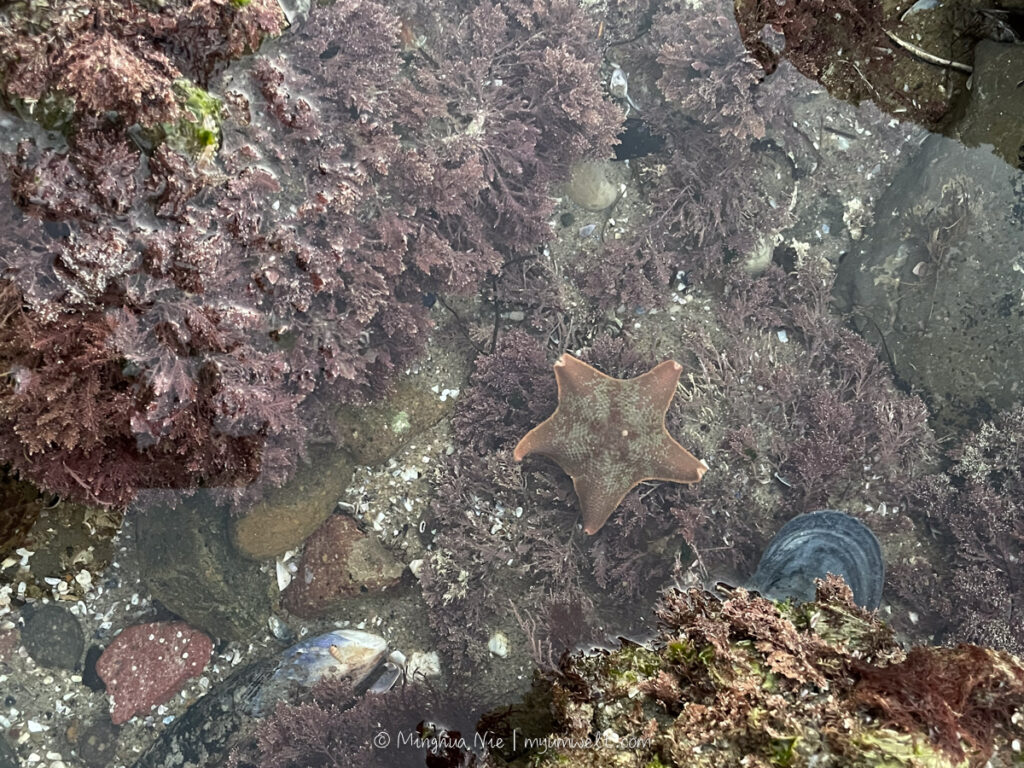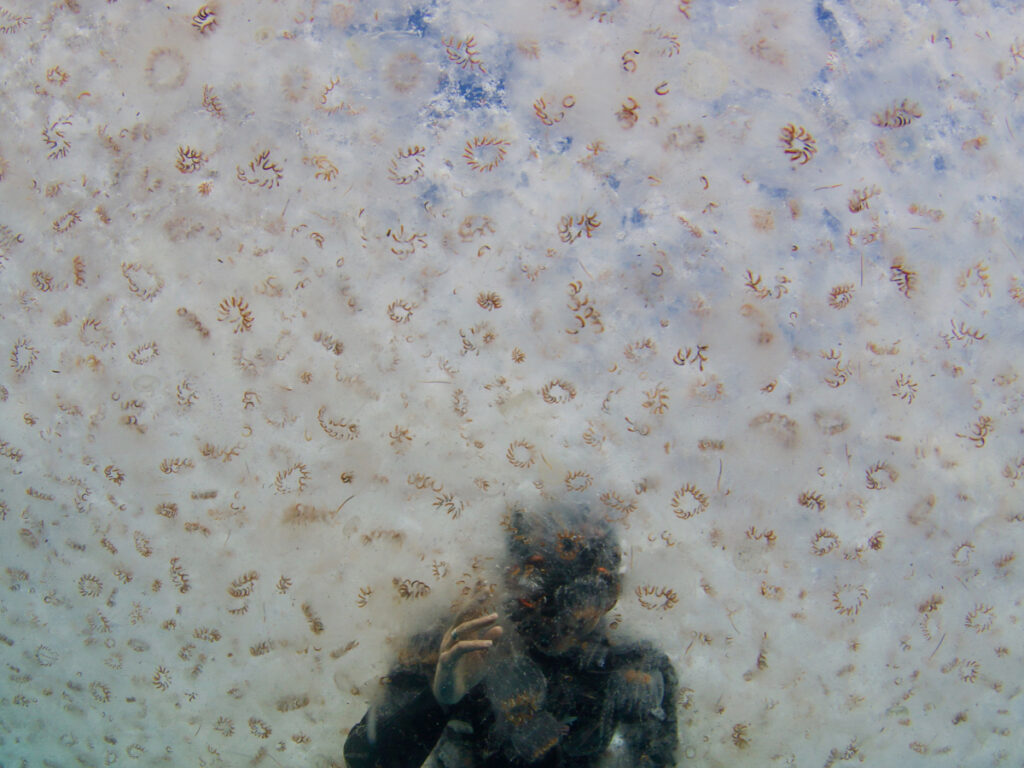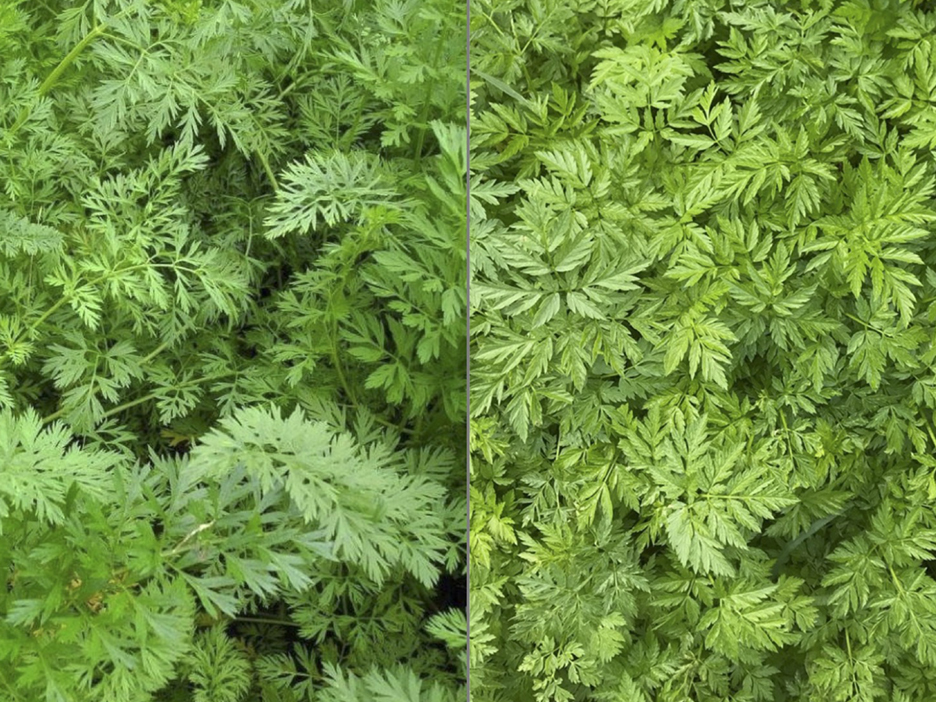
SALP POWER, pART I
In a 2018 episode of The Show About Science, a podcast for kids, Larry Madin talked about salps.
“How many people know about the salpa?” asked Nate, the seven-year-old host.
“Not very many,” Larry replied with a chuckle.
“Salps don’t get much respect. They have been around for millions of years, but hardly anyone even knows they exist.”
Naturalists have known a great deal about salps for almost two hundred years. Yet in our collective consciousness salp wears an invisibility cloak. This obscurity baffles me.
Cycles of Disappearance
Salps been known for their abundance. They were named Thelia by Patrick Browne and belong to the class Thaliacea. In Greek, τηαλια means “blooming,” a reference to their capacity to proliferate. Chance visitors of the coast, salps are conspicuous elements of the open ocean plankton. Imagine a place our roles reversed: In a blue expanse incomprehensibly vast to the human eyes, salps turn the ocean literally “salp-y,” catching attention of the rare visitors of the high sea.
Thomas Huxley is among the beholders of a salpy ocean.
“The Salpæ, those strange gelatinous animals, through masses of which the voyager in the great ocean sometimes sails day after day,” Huxley wrote in 1851, about sailing into salp blooms during his voyage aboard HMS Rattlesnake2.
From 1938 to 1941, Australian oceanographers conducted an exhaustive survey involving 304 stations. They found tunicates (salps and their relatives) were the second most abundant class of zooplankton. A research expedition off Australia in September 2006 found salps accounted for over 90% of the volume of all zooplankton they sampled from ocean surface and midwater. In four summers between 1975 and 2006, Larry Madin (WHOI) and Patricia Kremer (University of Connecticut) led expeditions to the Mid-Atlantic Bight region between Cape Hatteras and Georges Bank1. Each time they found one species, Salpa aspera, form dense swarms that lasted for months. One bloom covered 100,000 square kilometers of the sea surface—an area larger than the state of Indiana.
Salps are not rare, but they have been perceived to be so, which has as much to do with salp’s transparency as with human’s perceptions and bias.
“They have historically been ignored because they are difficult to sample and their gelatinous body structure suggests that they are unimportant in food webs and biogeochemical cycles,” concluded in a 2016 article, “Rethinking the Role of Salps in the Ocean3.” Longstanding misconceptions have attributed to salps’ invisibility to both the public and the scientific communities. Long story short, salps are often mistaken as jellyfish; they are seen to be too rare to be important; and they seem to have too little value to pay attention to.
Ironically, part of the reason that salps seem rare is because they are too numerous. Salp blooms clog up fishing nets. They also clog up plankton nets that marine ecologists use to sample for research. Their clear and delicate bodies are often broken in the process and difficult to identify (I have my share of experience in this!), so often they have been left out of the accounting. As a result, some of the earlier ecological surveys are questionable in their representativeness of ocean diversity. Salp’s easy disintegration in the stomachs of their predators also means that they are not recognized when scientists try to understand ocean food web by looking at stomach content. So for a long time, salps have also been considered an ecological dead end, meaning no one eats them. In fact, salps are widely consumed by hundreds of or more ocean species. Some species, like the leatherback sea turtles, feed exclusively on salps.
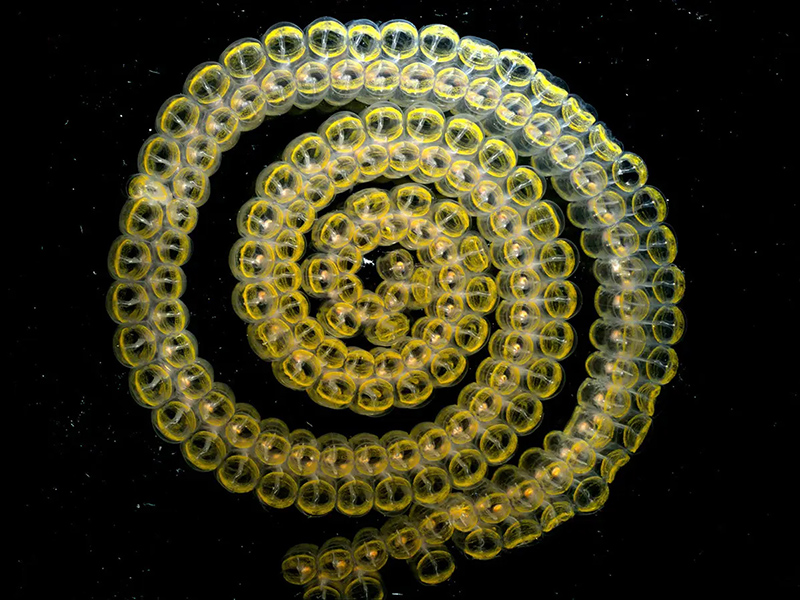
In recent years, a previously invisible connection between salps and humans has come to view—salps can really matter simply because of the way they eat and poop. As explained by Larry Madin, atmospheric CO2—a greenhouse gas that contributes to global warming— can be packaged and stored away.
Phytoplankton, by the process of photosynthesis, suck CO2 from the air and turn it into other forms of carbon to build their body. Salps eat phytoplankton and package carbon into larger, heavier parcels—salp poop, that prominent orange spot in Chamisso’s watercolor illustration, in Madin’s photo, and in the salps I saw on my swim. As large zooplankton, salps make large poops that can sink into the deep ocean to be locked away long enough that we won’t have to worry about it in our lifetime. So when astronomically large number of salps, “vacuuming” the vast ocean for carbon parcels, they have the potential of delivering Amazon-warehouse-equivalent amounts of packages of unwanted carbon down to the cold, dark, deep oblivion.
“Salps follow a ‘bloom or bust’ life cycle,” says Deborah Steinberg, professor at William & Mary’s Virginia Institute of Marine Science. The boom-bust cycles of human recognition of salps seem to loosely follow salp’s population oscillation between feast and famine. Every few years, salps catch our attention, but only briefly so, before they disappear then return as “aliens” and “heroes.” News reporting on salps in the past twenty years often paint them as alien-like superheroes—strange clear blobs that may help to fight global warming: “Meet the Ghostly Organisms that Rescue the Planet” (Evolution News, 2023); “These carbon-hungry blobs could help fix our oceans” (Grist, 2015); and, my favorite, “Ocean ‘Gummy Bears’ Fight Global Warming” (Live Science, 2006). A 2021 Guardian article lauded salps as powerhouses in curbing climate change, citing a study predicting salps remove billion tons of carbon each year.
All the features of salps have led scientists to suspect that they might play an important role as a biological carbon pump (BCP)— carbon dioxide removal through biological processes. Although, the proof is in the pudding (or, the jell-O). The ephemeral life cycle and uneven, unpredictable distribution of salps have long challenged efforts to study their role in carbon export and deep-sea food webs.
Finding Salps
Moira Décima made 2018 the year of the salps.
Décima earned her PhD in oceanography at Scripps Institute of Oceanography (SIO) in 2011. She returned to SIO as an assistant professor in 2020. Between those years, she worked at the National Institute of Water and Atmospheric Research (NIWA) in New Zealand. 2015, when Décima was on a research cruise studying Antarctic ecosystems, she saw sampling nets after nets pulling up lots of salps. Salp blooms seen as anomalies in most of the world occur regularly around New Zealand. Where other researchers saw a nuisance, Décima saw an opportunity. “If they come back year after year, I can write a research grant on salps,” she thought, so she decided to study salps instead of avoiding them. Décima applied for and was awarded funding from the Marsden Fund by the Royal Society of New Zealand. In October and November 2018, Décima led an international team on a month-long voyage to learn about salps. She named expedition “SalpPOOP”—”Salp and Particle expOrt Ocean Production.”
“The home of the salpæ is so remote from common observation that few persons except naturalists have a true conception of their scientific interest, or of their importance in the economy of the sea.”
The SalpPOOP voyage was the first expedition to find salp blooms and measure their contribution to carbon sequestration. On previous voyages of oceanographic studies, salp blooms have been chance encounters rather than the focus. Even though salps bloom more commonly in the New Zealand water, finding a salp bloom in an open ocean is not trivial. It is not like that there are signs marking salp’s presence, and don’t forget that they are kind of invisible. To find them, Décima looked for anecdotal clues: She went to places where fishermen find large schools of fish, such as Oreo and Warehou, that love to eat salps.

Décima also enlisted an army of citizen scientists to find salps. For The Year of The Salps Project, an army of snorkel-clad young scientists—students from Leigh Primary School—collected data on when and where salps appeared and communicated their findings to Décima. They used an app designed by Claudio Aguayo of AUT app lab. During her voyage, Décima sent updates back to students at Leigh and answered various questions students raised, like “Is a salp a boy or girl (answer: both)?” “Does Salp swim faster as an individual or as a chain (answer: depending on how old the chains are)?”
To me, one of the biggest achievements of the SalpPOOP project might well be that the children at Leigh are now well-informed about salps. “The most interesting part was finding out what salps were, because I thought they were just fish eggs,” said Noah. Five years have passed since the year of the salps. Do these children still remember salps? Will the seeds of local actions by citizen scientists germinate and eventually blossom into a global understanding of climate change? I am hopeful, knowing that a few solitary salps can seed immense blooms, when the conditions are right.
The SalpPOOP voyage sought to measure the effect of salps and to learn how they alter carbon export patterns. The team led by Décima traversed the water off the Canterbury coast and across the Chatham Rise to the east of New Zealand. They made hundreds of collections with bongo nets to depths down to 500 meters day and night. They found that one salp species, Salpa thompsoni, dominated the salp blooms. Comparing carbon composition in salp-rich water to zones without a lot of salps, the team observed that wherever they found high salp abundance, carbon export to ocean depth increased massively, regardless the ocean water mass type (subtropical or sub-Antarctic)4. It seems that salp blooms created an “expressway to the deep,” says Décima.
In 2018, around the time SalpPOOP voyage was launched, Deborah Steinberg of William & Mary’s Virginia Institute of Marine Science led the EXPORTS (Export Process in the Ocean from RemoTe Sensing) expedition, part of a NASA-funded multi-institutional program to quantify the global impact of the biological carbon pump. In the month-long voyage in the northeast Pacific Ocean, Steinberg’s team chanced on a large bloom of Salpa aspera. The salp bloom they found was more than 4,000 square miles, about the size of Connecticut. Their onboard experiments showed that salps could export 100 metric tons of carbon per day to the deep sea5.
Both expeditions and subsequent research confirm that as far as carbon packaging goes, salps can deliver. However, the question remains: would the ocean gummy bears don superhero capes and save the planet from our CO2 nightmare?
Salp Power
Over millions of years, salps have learned to seamlessly blend into their aquatic environment. Their invisibility protects them from predation. Some ocean organisms have already known how to take advantage of salp’s superpower. In a world of eating or being eaten, even transparent protection helps. The young driftfish and jacks hide inside large salps to thwart attackers, creating a strange sight of mini aquariums bobbing up and down in an immense ocean.
Humans have learned to see through salps’ disguises to unveil their hidden power of vacuuming CO2 into oblivion. Can we harvest this power to our advantage?
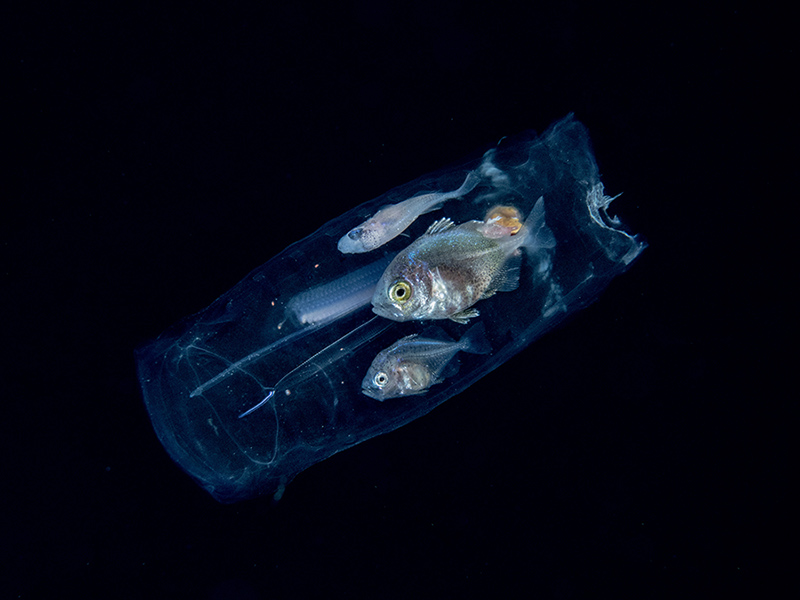
On a drizzling day in November 2023, I drove down the La Jolla Shores Drive, a scenic winding road I take regularly in early mornings to go swimming in the Pacific Ocean. The building where Moira Décima works is only ten minutes away from my work, Scripps Research. I wore a green jellyfish T-shirt to show my comradery with ocean gelatinous creatures. In her sparsely furnished office, Moira pulled a large cardboard box in front of my chair to serve as a table.
An hour of conversing about everything from her early childhood to the future of salp research went by quickly. When I asked about the possibility of harvesting the salp power to drive the biological carbon pump, an image of vast salp farms somewhere in the middle of a desert popped up in my head. Immediately, I recognized how ridiculous that would be. Currently, all laboratory salps are collected from the wild.
In terms of the geoengineering potentials of salps, “we are pretty far from having their biology done for that,” said Décima. We know some of the necessary conditions for their bloom, but not the sufficient conditions. Before being able to manipulate salps’ carbon pump power, we need to know—as the first step—enough about them, to predict their blooms. “Sampling zooplankton is just so much harder than phytoplankton because we can’t see them from space,” Décima told me after I brought up satellite detection of ocean algae blooms. Because phytoplankton blooms don’t necessarily lead to salp blooms, finding salps still relies on seaward search, which is very expensive.
“Basically, we just don’t have enough data,” said Décima, “they are very hard to study and to find.” She thinks that as a scientific community, we do have a goal in understanding the biological carbon pump better. “That’s what the EXPORTS program was about,” said Décima. But, achieving this will require a huge investment in oceanographic research.
Perhaps meanwhile we could still put salps to other uses. One of the coauthors of “Rethinking the Roles of Salps in the Ocean,” Iain Suthers, has eaten salps. “Mostly salty, and more nutritious than normal jellyfish!” Suthers wouldn’t mind adding us to the salp food chain. Well, are the oceans on Earth becoming more gelatinous with more salps and jellyfish? “We found no statistical difference between data we collected in 2008-2010 with that obtained in 1938-1942,” said Suthers.
Whatever salps can do for us, we’ll still need to find them first.
References:
- “Transparent Animal May Play Overlooked Role in the Ocean.” Https://Www.whoi.edu/, www.whoi.edu/oceanus/feature/transparent-animal-may-play-overlooked-role-in-the-ocean/.
- Thomas Henry Huxley, and Thomas Henry Huxley. “XXIV. Observations upon the Anatomy and Physiology of Salpa and Pyrosoma.” Philosophical Transactions of the Royal Society of London, vol. 141, 31 Dec. 1851, pp. 567–593, https://doi.org/10.1098/rstl.1851.0027.
- Henschke, Natasha, et al. “Rethinking the Role of Salps in the Ocean.” Trends in Ecology & Evolution, vol. 31, no. 9, Sept. 2016, pp. 720–733, https://doi.org/10.1016/j.tree.2016.06.007.
- Décima, Moira, et al. “Salp Blooms Drive Strong Increases in Passive Carbon Export in the Southern Ocean.” Nature Communications, vol. 14, no. 1, 2 Feb. 2023, https://doi.org/10.1038/s41467-022-35204-6.
- Steinberg, Deborah K, et al. The Outsized Role of Salps in Carbon Export in the Subarctic Northeast Pacific Ocean. Vol. 37, no. 1, 31 Dec. 2022, https://doi.org/10.1029/2022gb007523.
Notes:
- Another notable salp bloom off San Diego coast has been sighted in July 2024.
- Last update on August 1st, 2024.

